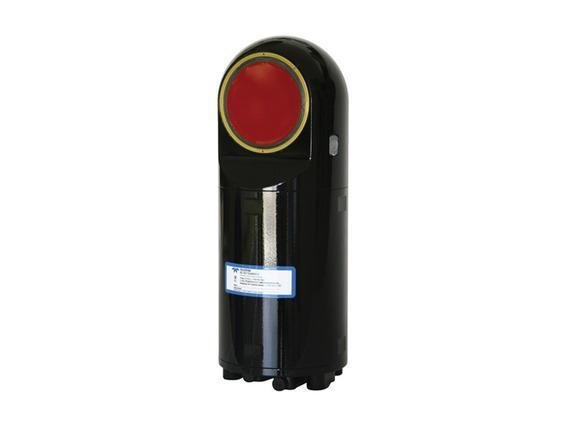System Sensors
Inertial Measurement Unit (IMU)
To navigate and localize around the mission course, we need the 3-axis heading and acceleration data, which we can use to determine the subs’ position. The Inertial Measurement Unit (IMU) is the sensor which allows us to achieve and obtain these variables. This year, we integrated our new Vectornav VN-100 IMU to both Graey and Onyx for greater precision and accuracy in heading and rotational acceleration data. In the previous competition, our AUVs were significantly impacted by electromagnetic interference (EMI) from the pool structure. IMU’s automatic Hard and Soft Iron (HSI) calibration feature mitigates magnetic interference from electromagnetic and metallic sources.
Doppler Velocity Log (DVL)
To localize our RoboSubs, we use the Waterlinked and Teledyne doppler velocity logs (DVL), respectively, for Graey and Onyx to process position estimation from obtaining its velocity input. To track translational motion, doppler velocity logs (DVL) are mounted onto both subs. The DVL estimates velocity relative to the sea bottom by sending acoustic waves from the four angled transducers and then measures the frequency shift (doppler effect) from the received echo. By combining the measurements of all four transducers and the time between each acoustic pulse, it accurately estimates the speed and direction of movement.
Imaging Scanning Sonar
We switched to Ping sonar from Blue Robotics for their increased image scanning capability. Previously we used the one dimensional ping sonar which only allowed us to receive distance values in the direction the sonar was pointing. The new 360 degree sonar allows us to get a snapshot view of our whole environment so we can analyze where the mission objects are and which direction we should head in.
Barometer
In the 3-D environment of the water, we introduce the axis of depth–the z axis. The mission course requires us to have the capability to sense and adequately adjust our depth to move under, move above, and align with the task elements. The barometer is the sensor which allows us to obtain the measurement which is aligned with the flight controller so that we can directly hold or set our depth. We developed our own Proportional Integral Derivative (PID) controller, which reads pressure from a barometer, to implement depth hold capabilities
Cameras
We equipped both of our AUVs with forward-facing and downward facing cameras. On Onyx, we have a front-facing USB low-light, front-facing OAK-D Wide, and bottom-facing OAK-D Wide, while Græy is equipped with a forward-facing OAK-D Wide and a bottom-facing USB low-light. OAK-D cameras divert processing power from our onboard computers, allowing us to easily run YOLOv8 models for object detection. OAK-D Wides have the two additional benefits of having an increased field of vision and an onboard IMU unit, which we can use as sensors to determine relative heading. We switch to USB low-light cameras when using OpenCV color thresholding and other OpenCV methods as they allow for higher resolution images in low-light conditions. On both subs, we have USB low-light, OAK-D, and OAK-D wide cameras. The OAK-D Wide cameras have Inertial Measurement Units (IMU), as do the Pixhawk controllers.
Modem
To safely and effectively operate two subs simultaneously in the water, it is paramount to have a consistent and efficient communication system. This season, we emphasize the importance of being able to have two submarines effectively communicate with each other in the water, in addition to providing useful information to the ground station such as images, updates on current tasks, and other odometry status messages. Our original design was modeled around the compact m64 modems by WaterLinked. To test these modems, we developed a bench test utilizing a raspberry pi and a hobbyist power divider/regulator for power and serial communication. The results of these modem tests demonstrated that they were unreliable and their 64 bits per second were insufficient if we desired to send any images. This led us to begin implementing new modems that were more reliable and offered a higher bandwidth.
Fiber Optic Gyroscope (FOG)
The Fiber Optic Gyroscope is used to obtain information about the sub’s heading. The FOG is more accurate than other onboard compasses because it is immune to electromagnetic interference. Although we can use the Hard Soft Iron (HSI) sensor calibration to improve our VN-100 gyroscope, heading precision is still not extremely precise. The FOG presents a solution to this problem as it is immune to electromagnetic interference, which is the main issue of of the compass. This way, it provides accurate and precise azimuth heading data. We are using the single-axis Fizoptika Malta VG103 S2LND FOG, which requires a gimbal to mount on our subs in order to collect precise heading data around the three dimensions.
Hydrophone
We offloaded as much filtering as possible to custom designed hardware, freeing up resources within the microprocessor. Each hydrophone has its own daughter-board containing noise-isolated circuitry. This includes the pre-amp, a custom amp, a custom variable frequency filter, adjustable between 10khz to 40khz, a digital potentiometer for variable gain, and a custom active high-pass filter to ensure the signal is as clean as possible.










